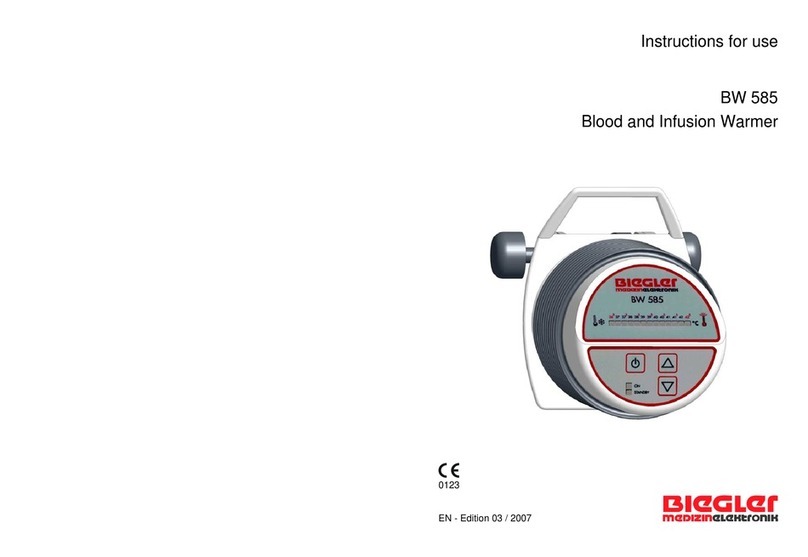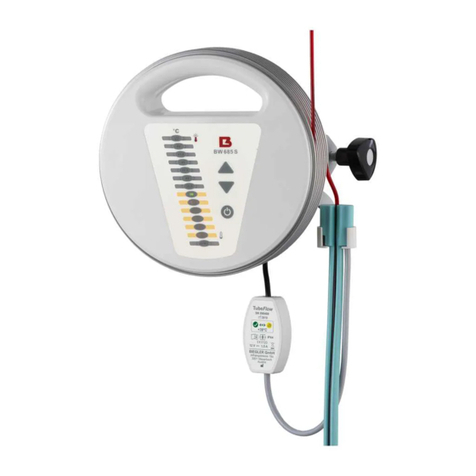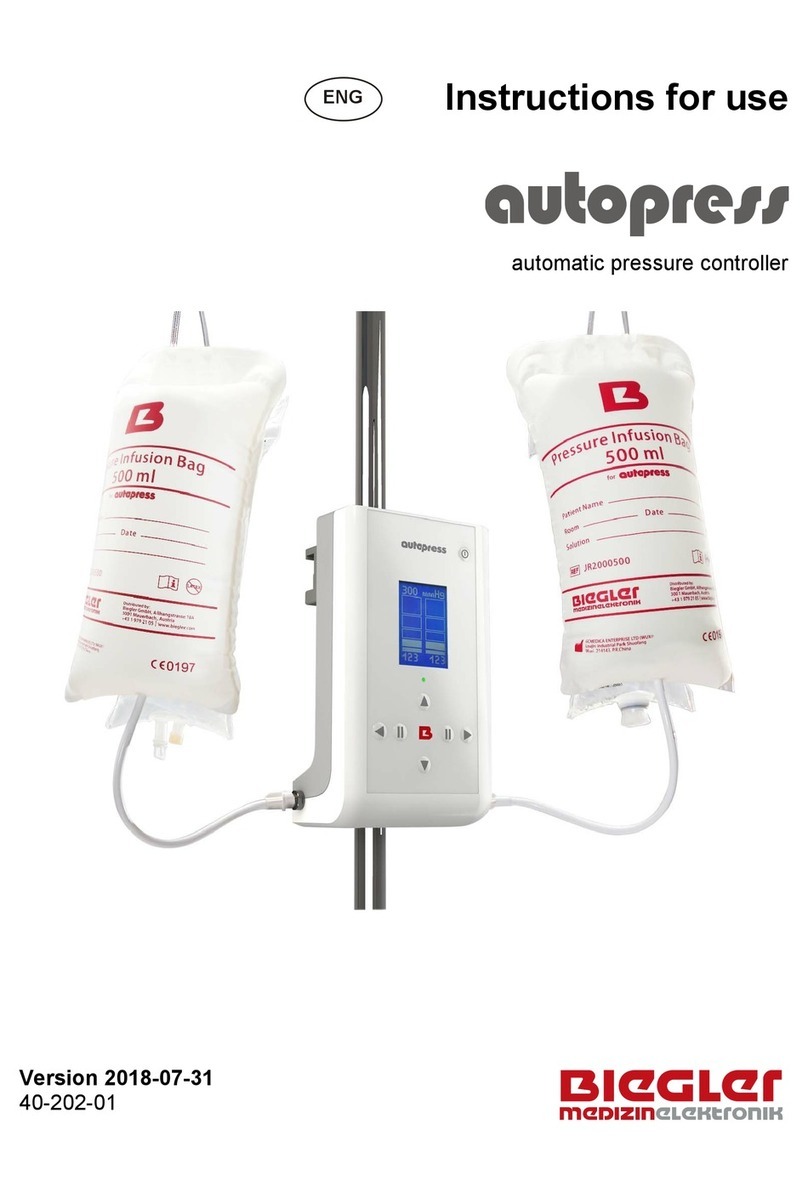Biegler RESPIFIT S User manual

Instructions for use
Patients
RESPIFIT S
Inspiratory Muscle Training
Device
Edition 2021-05-18 | 40-246-03
Sales Manufacturer
ENG

RESPIFIT S
2
IMPORTANT
These instructions for use are essential for operating the
device. They must be kept in a suitable place near the
device, and should be kept with the device. If the device is
transferred to another user, the instructions for use must be
supplied with it.
For proper and safe operation and use of this device, it is
essential that the instructions for use, including safety
instructions and warnings, are read and complied with prior
to commissioning. It is the user’s responsibility to fully
familiarise themselves with how to operate the device
correctly.
Target group:
These instructions for use are aimed at patients who use the
RESPIFIT S.
More information on the settings and functions is available for clinical
users such as physiotherapists, care staff and doctors in the RESPIFIT S
(clinic) instructions for use.

RESPIFIT S
3
Table of Contents
1DESCRIPTION.............................................................................................................................. 4
1.1 GENERAL DESCRIPTION.............................................................................................................. 4
1.2 INTENDED USE ........................................................................................................................... 4
1.3 INDICATION................................................................................................................................. 5
1.4 CONTRAINDICATIONS .................................................................................................................. 5
1.5 SCOPE OF DELIVERY................................................................................................................... 5
1.6 ACCESSORIES ............................................................................................................................ 6
2GENERAL SAFETY INSTRUCTIONS.......................................................................................... 6
3INITIAL OPERATION AND USE .................................................................................................. 8
3.1 HANDHELD PATIENT MODULE....................................................................................................... 9
3.2 DATAKEY.................................................................................................................................. 11
3.3 CONNECTING THE DEVICE AND ACCESSORIES............................................................................. 12
3.4 SETTING UP BEFORE TRAINING .................................................................................................. 12
4TRAINING WITH THE RESPIFIT S............................................................................................ 13
4.1 THE STRENGTH EXERCISE ......................................................................................................... 13
4.2 THE ENDURANCE EXERCISE....................................................................................................... 16
4.3 RESULTS DISPLAY..................................................................................................................... 19
4.4 DECOMMISSIONING................................................................................................................... 19
5CLEANING.................................................................................................................................. 20
6MAINTENANCE.......................................................................................................................... 22
6.1 TROUBLESHOOTING.................................................................................................................. 22
6.2 PERIODIC INSPECTIONS ............................................................................................................ 22
7RETURNING DEVICES OR ACCESSORIES ............................................................................ 23
8DISPOSAL .................................................................................................................................. 23
9MANUFACTURER LIABILITY.................................................................................................... 24
10 WARRANTY CONDITIONS........................................................................................................ 24
11 ELECTROMAGNETIC COMPLIANCE....................................................................................... 26
11.1 EMISSIONS............................................................................................................................... 26
11.2 IMMUNITY TEST LEVEL............................................................................................................... 26
12 SYMBOLS................................................................................................................................... 27
13 OPERATING AND STORAGE CONDITIONS............................................................................ 28
14 TECHNICAL DATA..................................................................................................................... 29
15 MANUFACTURER AND SALES................................................................................................ 30
16 MANUFACTURER’S DECLARATION ....................................................................................... 30

RESPIFIT S
4
1 DESCRIPTION
1.1 General Description
The RESPIFIT S is a portable device for inspiratory muscle training.
The device is designed for the following indications: Patients with chronic
obstructive pulmonary disease and lung emphysema; for pre- and post-
operative respiratory therapy in association with pulmonary rehabilitation
and for patients with neuromuscular diseases involving the respiratory
muscles at an early stage of the disease.
The RESPIFIT S can be used to set up training programmes to increase
both strength and endurance of the respiratory muscles. Integrated
functions can also determine the capacity of the inspiratory muscles, i.e.
the strength and endurance of this muscle group.
An essential component of the device is the graphical representation of
the exercise sequence, which shows the patient whether he/she is
actually complying with the required training intensity
The patient’s individual exercise and configuration data is stored on the
removable datakey.
The interchangeable handheld patient module offers the ultimate in
hygiene and safety.
1.2 Intended Use
The RESPIFIT S is designed for personal training to increase the
strength and endurance of the inspiratory respiratory muscles in patients
from the age of 10 years.

RESPIFIT S
5
1.3 Indication
Chronic obstructive pulmonary diseases (COPD)
•For COPD stage GOLD II –IV as a measure that is ancillary to
established medicinal therapy and rehabilitation procedures.
Neuromuscular diseases
•Slowly progressive course
•Inspiratory vital capacity > 25% of the reference value
•paCO2 (Carbon dioxide partial pressure in the blood) < 45 mmHg
Other disease patterns involving respiratory muscle weakness,
such as
•Cystic fibrosis
•Kyphoscoliosis or diaphragm dysfunction
•Pre- and post-operatively in thoracic procedures
•Chronic heart failure
1.4 Contraindications
•Any acute disease
•Any acute change in condition, also as part of a chronic underlying
condition
•Any chronic underlying condition that is not sufficiently controlled
with treatment, e.g. arterial hypertension or diabetes
1.5 Scope of delivery
Number
Description
Catalogue number
1
RESPIFIT S device
LR1003004
from SN: 402005
1
RESPIFIT S instructions for use
clinic and patient
FK1003008
FK1003009
1
Handheld patient module
IB1002001
1
Datakey
AG6110050
1
Power supply unit Mean Well Type
GEM06I05
CJ1003004
Table of contents
Other Biegler Medical Equipment manuals
Popular Medical Equipment manuals by other brands

Getinge
Getinge Arjohuntleigh Nimbus 3 Professional Instructions for use

Mettler Electronics
Mettler Electronics Sonicator 730 Maintenance manual

Pressalit Care
Pressalit Care R1100 Mounting instruction

Denas MS
Denas MS DENAS-T operating manual

bort medical
bort medical ActiveColor quick guide

AccuVein
AccuVein AV400 user manual

















